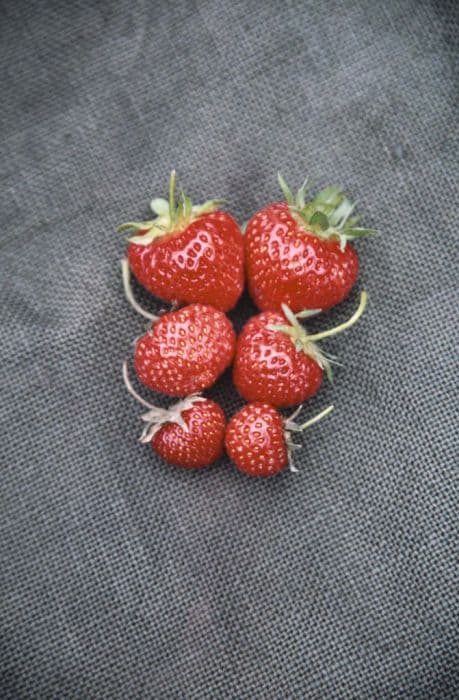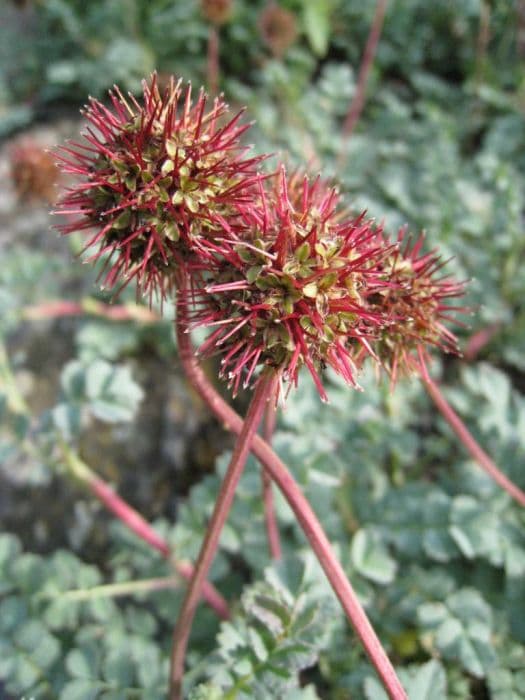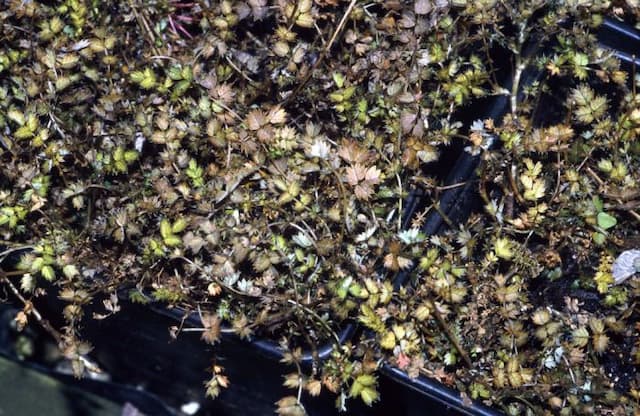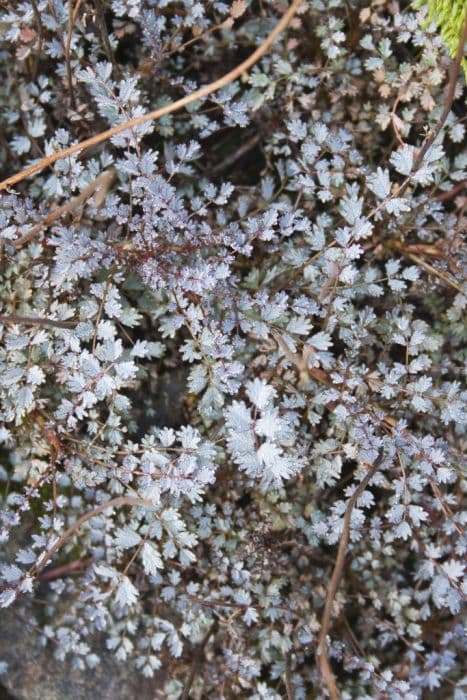Strawberry Fragaria × ananassa 'Cambridge Favourite' (F)

ABOUT
The Cambridge Favourite strawberry is a popular variety for its delightful taste and reliable growth habit. This plant is characterized by a lush, green foliage that provides a backdrop to the vibrant red fruits it bears. The leaves are typically broad with a slightly serrated edge, offering a textural contrast in the garden. During its blooming season, it sprouts white flowers that have a golden center; these blossoms are modest in size but stand out against the green leaves. Following these flowers, the plant produces its signature strawberries, which are known for their bright red color and plump, heart-shaped form. These berries are glossy and inviting, often dotted with numerous small seeds that add to their classic appearance. The strawberries are not only attractive but are also reputed for their juicy texture and sweet flavor, making them a garden favorite for fresh eating, as well as for use in jams and desserts. Overall, the appearance of the Cambridge Favourite strawberry plant is one of abundant vitality, with the fruits demarcating seasons of harvest and enjoyment.
About this plant
 Names
NamesFamily
Rosaceae
Synonyms
Garden Strawberry, Strawberry
Common names
Fragaria x ananassa Duchesne ex Rozier, Fragaria chiloensis x Fragaria virginiana, Fragaria ananassa.
 Toxicity
ToxicityTo humans
The plant commonly known as the garden strawberry is not toxic to humans. It is a widely cultivated fruit plant, and its berries are commonly consumed with no adverse effects. There are no known toxic components in the fruit, leaves, or any other part of the plant that would cause poisoning in humans. Consumption of garden strawberries is generally considered safe.
To pets
The garden strawberry plant is not considered toxic to pets. Both dogs and cats can consume the fruit safely, and there are no known toxic substances in the leaves or other parts of the plant that could cause harm to pets. While the strawberry fruit is nontoxic, pets consuming large quantities might experience gastrointestinal upset due to the fiber content or if they are not used to eating such foods. However, typical ingestion of the garden strawberry does not pose a risk of poisoning for pets.
 Characteristics
CharacteristicsLife cycle
Perennials
Foliage type
Deciduous
Color of leaves
Green
Flower color
White
Height
0.5 feet (15 cm)
Spread
1.5 feet (45 cm)
Plant type
Herb
Hardiness zones
5
Native area
Americas
Benefits
 General Benefits
General Benefits- Nutritional Value: Strawberries are rich in vitamins C and K, providing essential nutrients.
- Home Gardening: Easy to grow and maintain, making it a popular choice for home gardens.
- Aesthetic Appeal: The plant adds beauty to gardens with its lush green foliage and vibrant red fruits.
- Pollinator Attraction: Flowers attract bees and other pollinators, supporting biodiversity.
- Culinary Versatility: The fruit can be used in a wide range of recipes, from desserts to savory dishes.
- Community Engagement: Often grown in community gardens, fostering social interaction and cooperation.
- Economical: Home cultivation of strawberries can reduce grocery bills.
- Wildlife Support: Provides food for birds and small animals.
- Educational Tool: Can be used to teach children about plant growth and gardening.
- Seasonal Harvest: Offers a seasonal crop that can be harvested and enjoyed fresh.
 Medical Properties
Medical Properties- This plant is not used for medical purposes.
 Air-purifying Qualities
Air-purifying QualitiesThis plant is not specifically known for air purifying qualities.
 Other Uses
Other Uses- Strawberry infused vinegar: Fragaria × ananassa 'Cambridge Favourite' can be used to create a fruity vinegar that can add a sweet and tangy flavor to salads and marinades.
- Natural dye: The fruit can be used to produce a natural pink dye for fabrics or crafting materials.
- Strawberry leaf tea: Though not as common as the fruit, the leaves of the strawberry plant can be dried and used to make a mild, fruity tea.
- Strawberry scented candles: The aroma of strawberries can be infused into candles to create a sweet and welcoming household scent.
- Companion planting: Fragaria × ananassa 'Cambridge Favourite' can be planted alongside certain vegetables to help deter pests, as part of a companion planting strategy.
- Edible cake decorations: Fresh strawberries can be used as natural and edible decorations on cakes and other desserts.
- Strawberry jam art: Making jam doesn't have to be just for the jar; creative individuals use different fruit jams like strawberry to paint edible art on bread or desserts.
- Ice cube flavoring: Pieces of strawberries can be frozen in ice cubes to add a burst of flavor and visual appeal to drinks.
- Botanical skincare: Strawberry seeds and pureed fruit can be incorporated into homemade exfoliating face masks or scrubs.
- Plant pigment experiments: The juice from Fragaria × ananassa 'Cambridge Favourite' is ideal for educational science experiments to explore natural pigments and pH indicators.
Interesting Facts
 Feng Shui
Feng ShuiThe strawberry plant is not used in Feng Shui practice.
 Zodiac Sign Compitability
Zodiac Sign CompitabilityThe strawberry plant is not used in astrology practice.
 Plant Symbolism
Plant Symbolism- Innocence: Strawberries have often been associated with purity and innocence due to their bright red color and sweet taste, reminiscent of the simplicity and wholesomeness of childhood.
- Love and Passion: The heart shape and red color of strawberries make them a symbol of Venus, the goddess of love. They represent romantic attraction and desire in many cultures.
- Fertility: As a fruit that bears seeds on the outside, strawberries are frequently seen as a symbol of fertility and abundance.
- Perfection and Goodness: The perfect symmetry and luscious taste of strawberries have led to their association with the good things in life and the perfection of nature.
- Prosperity: In some folklore, strawberries are linked to prosperity and plenty, reflecting the fruit's abundance during its season.
 Water
WaterStrawberry plants, including the 'Cambridge Favourite', require consistent moisture, especially during the growing season. They should be watered deeply at least once a week with about one to one and a half gallons of water per square yard, increasing to twice a week during dry periods. Avoid overhead watering to reduce the risk of fungal diseases; instead, use drip irrigation or water at the base of the plants. During fruit development and harvest, ensure the plants receive enough water, as strawberries are 90% water by weight. In cooler weather or when the plants are dormant, reduce watering.
 Light
LightStrawberries, such as the 'Cambridge Favourite', thrive in full sun, meaning they require at least six hours of direct sunlight each day. The best spot for these plants is in an area where they will receive early morning sunlight, which helps dry dew on the leaves, thereby reducing the risk of disease. However, they can tolerate partial shade, particularly in hotter climates where afternoon shade can prevent overheating.
 Temperature
TemperatureThe 'Cambridge Favourite' strawberry plant prefers temperatures between 60°F to 80°F for optimum growth. It can survive minimum temperatures down to about 20°F, but frost can damage fruit and flowers. During the flowering and fruiting stages, protect the plants from frost by covering them with a frost blanket. Ideal fruiting occurs when daytime temperatures are around 65°F to 75°F, with cooler nights.
 Pruning
PruningPruning strawberry plants like the 'Cambridge Favourite' involves removing dead leaves and spent flowers after fruiting to promote healthy growth and prevent disease. The best time for a major prune is right after harvesting, usually mid to late summer. Thinning the plants every year or two ensures that the strawberry patch doesn't become overcrowded, which can reduce yields and increase disease pressure.
 Cleaning
CleaningAs needed
 Soil
SoilStrawberry 'Cambridge Favourite' thrives in a soil mix with good drainage, high in organic matter, with a pH between 5.5 and 6.8. A mix of one part loam, one part sand, and two parts compost or well-rotted manure can provide a balanced environment, offering nutrients and proper aeration.
 Repotting
RepottingStrawberry 'Cambridge Favourite' plants should be repotted or renovated every 2-3 years to maintain vigor and ensure healthy fruit production, ideally after the harvest season.
 Humidity & Misting
Humidity & MistingStrawberry 'Cambridge Favourite' plants prefer moderate humidity levels, typically between 50-80%, which is often naturally present in outdoor environments and can be maintained indoors with regular misting or a pebble tray.
 Suitable locations
Suitable locationsIndoor
Ensure bright light, cool temps, and moist soil for indoor strawberries.
Outdoor
Plant in full sun, enrich soil with compost, water regularly.
Hardiness zone
4-9 USDA
 Life cycle
Life cycleThe garden strawberry (Fragaria × ananassa 'Cambridge Favourite') begins its life cycle with seed germination, where under favorable conditions of warmth and moisture, the seed produces a small seedling. The seedling then develops into a vegetative plant with leaves and a root system capable of photosynthesis and nutrient uptake. As the plant matures, it enters a phase of reproductive development where it produces flowers, typically initiated by longer days and warmer temperatures in spring. After pollination, usually by insects, the flowers develop into fruits—the strawberries—each containing seeds which can complete the life cycle. Alongside sexual reproduction, this perennial plant can also propagate vegetatively through runners that extend from the main plant and take root in the soil, forming new plants. The life cycle continues as these new plants mature and eventually produce their own flowers, fruits, and runners.
 Propogation
PropogationPropogation time
Spring-Early Summer
The most popular method of propagating the strawberry 'Cambridge Favourite' is through runner division. Typically, the best time to propagate strawberries in this manner is in late summer or early fall, which gives the new plants enough time to establish before the onset of winter. During their growing season, strawberry plants produce long, horizontal stems called runners that touch the ground and eventually sprout small clones at various points along these runners, called plantlets. Gardeners pin or peg these plantlets into the soil or into pots filled with potting mix while they are still attached to the parent plant, allowing them to establish roots. Once the plantlets are well-rooted, usually after a few weeks, the connecting runner can be snipped, and the new strawberry plants can be transplanted to a desired location in the garden or larger containers if necessary.









